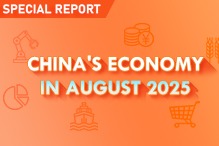Why cross-border capital may flow into China's ESG space


The time has come when ESG investing-which considers environmental, social and governance factors in investment decisions-is increasingly a why-not phenomenon in China.
The country has been a strong advocate of promoting sustainable financing and decarbonization efforts, and is undertaking one of the largest energy grid transformations toward renewable energy globally. Home to the world's second-largest green bond market, there were over $270 billion of green bonds outstanding as of the end of 2021.
As such, we believe there are opportunities in ESG investing in China for investors searching for impact opportunities and financial return objectives.
China's ESG standards have been aligning with international standards more rapidly than ever. This is expected to accelerate the pace of cross-border flows into sustainable finance.
China's green taxonomy was first released in 2015. The revised edition, published in 2021, shows improvements in the alignment of China's taxonomy with international standards. The latest taxonomy presents clear green definitions at the activity level in China with the aim of enhancing disclosure and transparency across the board.
In 2020, the European Union and China initiated a working group within the International Platform on Sustainable Finance to undertake a technical comparison of taxonomies from the two jurisdictions. The Common Ground Taxonomy puts forward areas of commonality and differences between the EU and China's green taxonomies, providing a valuable tool to enable the comparability and interoperability of these taxonomies.
We believe the convergence between these taxonomies will continue to happen, which can help promote China's sustainable investment at home and abroad. Such breakthroughs are expected to further spur cross-border investment in this space.
In addition, China is in the midst of a rapid scale-up of renewable capacity that is unparalleled globally.
Since 2015, the nation's renewable energy capacity has surpassed that of Europe. China is now the world's dominant supplier of solar modules, wind turbines and lithium-ion batteries. The rate of change has been unprecedented.
For example, total new offshore wind power brought online in China last year was 1.6 times the total offshore wind capacity in the United Kingdom. Non-fossil fuel energy is expected to make up around 17.3 percent of total energy production this year and is expected to increase to 80 percent by 2060.
China's 2060 carbon neutrality target represents a significant investment opportunity. We expect more green bond issuers to emerge across a wide range of sectors in both the private and sovereign spaces. In addition, we expect further innovation in sustainable bond formats, such as China's carbon neutrality bond format, which is being viewed by some as an even greener bond given its stricter use of proceeds.
In particular, we believe there are seven key thematic opportunities that currently exist in China around sustainable investing.
First is clean water and biodiversity. The proportion of State-controlled water assets with good quality surface water (Grades I, II and III) increased from 66 percent in 2015 to 83 percent in 2020. A number of local government financing vehicles play a key regional and local role in improving access to water and sanitation in cities alongside waste management.
We favor issuers with clear policy objectives where there is stronger government support to ensure financial stability. Meanwhile, reducing water pollution and improving water quality is a key pillar supporting biodiversity in China. The country is also playing an international role in improving biodiversity in developing countries.
Second is social orientation. Poverty reduction has been a key success story amid China's economic transformation. The World Bank said China's efforts in this area contributed to global extreme poverty alleviation by over 75 percent over the past 40 years. There are several local government financing vehicles aligned with this theme that have an integral role to play in urban redevelopment and affordable housing.
Third is clean energy. Given their scale, select Chinese issuers are seen as global enablers of clean energy, such as large battery producers and electric vehicle manufacturers. In addition, issuers that adopt clean energy, particularly major electricity consumers, are also critical in accelerating the national shift toward clean energy.
For example, the Chinese tech sector has a key role to play in developing green and energy-efficient data centers for the digital economy, particularly as data centers are expected to account for around 4 percent of China's total electricity consumption by 2030.
Fourth is top-down driven net-zero transition. We have already observed that State-owned enterprise issuers from heavy carbon-emitting sectors such as energy, utilities and aluminum, are setting targets to support China's net-zero goals. This trend is expected to drive carbon target setting in SOEs as well as the private sector.
The key investment implication of this is that, over time the investment universe for Chinese fixed income is expected to become more strongly geared toward decarbonization objectives.
Fifth is sustainable cities and infrastructure. Cities cannot be sustainable without infrastructure that supports sustainable transport nodes. China currently accounts for around a quarter of the world's urban rail transit by length and we see potential investment opportunities in the metro issuers that are active in major Chinese cities.
Sixth is sustainable finance. In November, the People's Bank of China, the central bank, rolled out measures to support low-cost loans to financial institutions. As of May, the PBOC offered policy support to financial institutions to issue green and low-carbon loans totaling 230 billion yuan ($34.34 billion), which equates to around 47.8 megatons of annual carbon dioxide reduction.
Seventh is climate adaptation. Areas of focus include the protection of coastal belts, agricultural land and water. Reforestation has a strong focus on building up the country's carbon sink capacity within its ecosystems. As of the end of 2020, China's forested areas stood at 220 million hectares and its forest coverage reached 23 percent, with forest carbon storage approaching 9.19 billion metric tons.
As China's efforts in sustainable development continue to bear fruit, we believe new investment opportunities may also emerge. There is scope for China to become a core holding of any investor who is seeking to make an environmental impact.
The alignment of China's ESG standards with international standards also allows for international investors to take part in the internationalization of sustainable finance in China. The magnitude of the energy transition that needs to take place in the next five to 10 years is unprecedented, and this entails significant investment needs.
The writers are Norbert Ling, an ESG credit portfolio manager at Invesco Fixed Income, and Zhong Haidan, a senior client portfolio manager at Invesco, a global investment management company.
The views don't necessarily reflect those of China Daily.




































